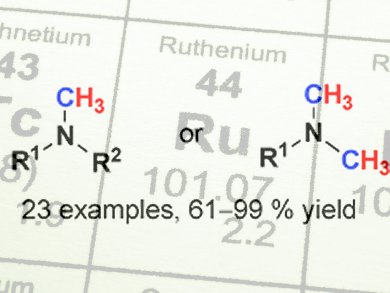Catalytic Activation of CO2
Carbon dioxide is the most common source of carbon in nature and an inexpensive building block that is useful for the chemical industry. However, because of its high stability, it is not easy to induce CO2 to react. In the journal Angewandte Chemie, German scientists have now reported a universally applicable method for the catalytic methylation of amines with CO2.
A variety of methods have previously been developed with the goal of attaching CO2 to various organic molecules to convert them into intermediate products for chemical syntheses. Indispensable to all of these techniques is a suitable catalyst that activates the CO2 for the reaction in question. To date, no one has developed a general method for the catalytic methylation of amines by CO2. In this reaction, CO2 is bound to the nitrogen atom of the amino group and is converted (reduced) to a methyl group (–CH3). Amine methylation methods currently available generally depend on toxic substances.
Matthias Beller and his co-workers at the Leibniz Institute for Catalysis in Rostock, Germany, have now described a catalyst that is able to generally convert carbon dioxide and diverse amines into products that are methylated at the nitrogen atom.
General Methylation Procedure for Almost All Types of Amines
The secret of their success is a ruthenium complex that reacts with a special phosphoric ligand in situ to become an active catalyst. In addition, phenylsilane, an organosilicon compound, is used as a reducing agent. For the actual reaction, the metal complex, ligand, and silane, are placed in an autoclave with toluene as solvent and the amine to be methylated. CO2 is introduced at a pressure of 30 bar and the mixture is stirred at 100 °C for several hours.
This new catalytic process makes it possible to selectively methylate almost all types of amines—secondary and primary, aromatic and aliphatic—in high yields. The amines are converted to the desired tertiary amines and diamines. Even urea can be used as a starting material. In contrast to many other known methylation methods, the presence of other functional groups, such as nitrile, olefin, ether, ester, or hydroxy groups pose no problem. They are not affected so protecting groups are not needed.
“We have demonstrated for the first time that the general methylation of organic substrates using silanes and CO2 as a simple carbon source is possible,“ says Beller. “The catalyst consists of a commercially available ruthenium complex and ligand formerly developed by our group.”
- A General Catalytic Methylation of Amines Using Carbon Dioxide,
Yuehui Li, Xianjie Fang, Kathrin Junge, Matthias Beller,
Angew. Chem. Int. Ed. 2013.
DOI: 10.1002/anie.201301349




